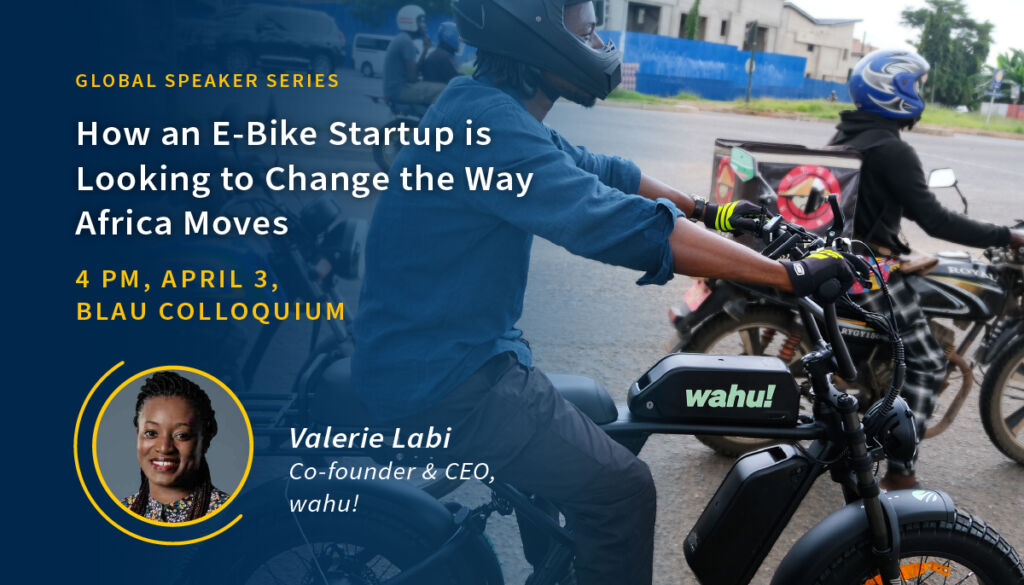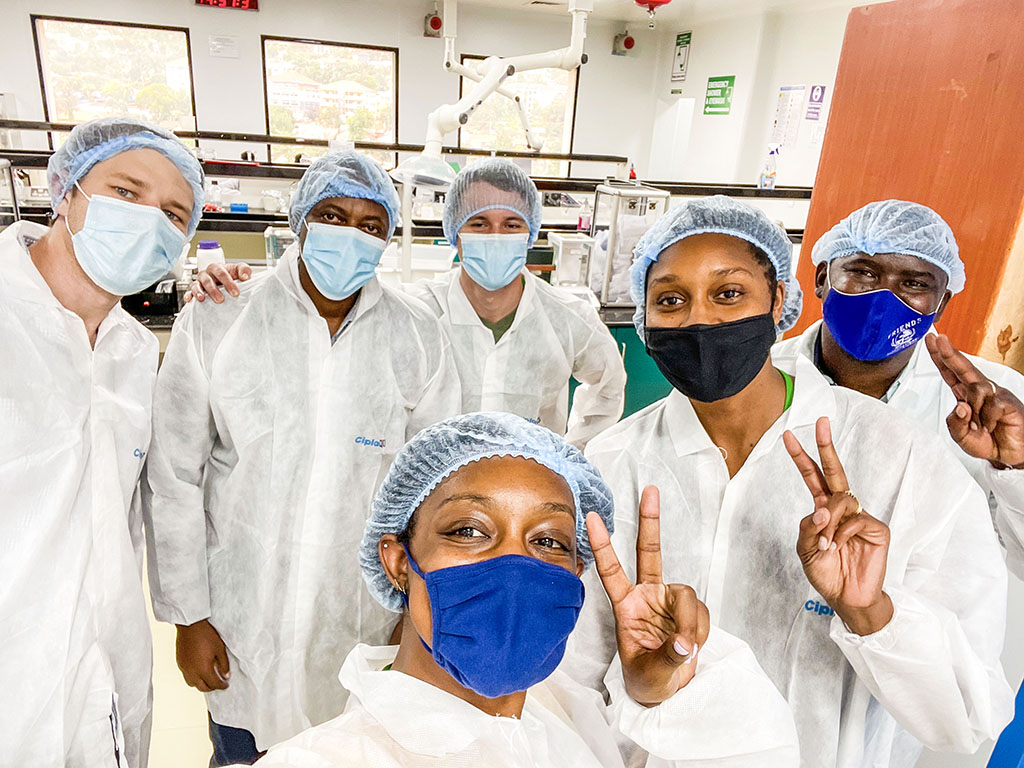With a growing middle class, early-stage frontier markets, enormous demographic advantages, and its ongoing digital transformation, Africa continues to grow in both economic and geopolitical importance. In “Demystifying Africa’s Risk Perception Premium,” Paul Clyde and co-authors make the case for a stronger U.S.- Africa trade and investment relationship, one that changes the narrative around doing business on the continent.
Time: 4 PM EDT
Date: April 3, 2024
Location: Blau Colloquium, 5th floor of the Blau Building at the Ross School of Business
wahu! is the first Ghanaian brand to produce electric vehicles domestically. The electric bike (e-bike) startup brings together local talent and experienced automotive engineers and designers from global automakers, including Audi and BMW.
In the talk, “How an E-Bike Startup is Looking to Change the Way Africa Moves,” Valerie Labi, co-founder and CEO of wahu! Mobility Ltd. will discuss how the business is unlocking new possibilities in low-emission mobility solutions, particularly in urban markets. By locally designing and manufacturing connected EVs for Africa and the wider world, wahu!’s value proposition includes ease of transport, a path to vehicle ownership and a gateway to sustainable employment through mobility services.
Labi is an entrepreneur who also served as Ghana country director for nonprofit iDE, International Development Enterprises, which focuses on market-based solutions in agriculture and water/sanitation. She received her Bachelor of Science degree in Economics from the University of Southampton and her Masters of Studies from the University of Cambridge in Sustainability Leadership.
This event is open to the public and sponsored by the William Davidson Institute at the University of Michigan (WDI) in partnership with the African Studies Center at U-M’s College of Literature, Science, and the Arts.
Attendees are encouraged to register (see below or click here) and submit questions in advance. Light refreshments will be served.

![]()
![]()
WDI is partnering with the U-M School of Engineering’s Global Health Design Initiative, the Aerospace Engineering department and a doctor in Ghana to iterate on a design of a hand rehabilitation device with an eye toward commercialization in a Ghana Rehabilitation facility. The latest prototype was produced using 3D printing and the new “Grip Forté” is currently being field tested in Ghana. The team is expanding the project building a 3D printed PETG recycling device.
Powertrust connects corporate climate leaders with renewable energy projects in emerging markets by facilitating the issuance and sale of renewable energy credits (RECs). A team of MBA students worked with Powertrust to analyze the current interactions and potential market in Ghana.
WDI is partnering with the U-M School of Engineering’s Global Health Design Initiative and the Aerospace Engineering department to iterate on a design of a hand rehabilitation device with an eye toward commercialization in a Ghana Rehabilitation facility. The initial prototype was constructed of wood and the next iteration will be produced using 3D printing. The team is exploring working with Hewlett Packard in Africa.
The International Center for Rehabilitation (ICR) is a new rehabilitation clinic in Kumasi, Ghana opened by Dr. Abena Tannor, the first practicing physical medicine and rehabilitation physician in Ghana. This project focused on research related to the commercialization of a hand rehabilitation device and viability of setting up a 3D printing facility.

U-M Business students explore a laboratory as part of a WDI-sponsored project in Uganda with partner Busoga Health Forum (BHF). BHF’s goal is improving health in the Busoga region by developing new services and products. The U-M team provided a market assessment and recommendations for developing a diabetes product.
When faced with the task of choosing her MBA project, Alexis Kenworthy, a dual-degree graduate student, knew she could rely on the William Davidson Institute (WDI). She’d already connected with the Institute to work on the International Investment Fund project, and she’d been prioritizing international work since before her time at the University of Michigan’s Ross School of Business.
“WDI provides opportunities that I didn’t see exist in the traditional classroom setting. Business is becoming so international, and WDI is on the forefront of that,” said Kenworthy, who participated in two WDI-sponsored projects.
As Kenworthy noted, substantial real-world experiences elevate a business education, and each year students at the University of Michigan’s Ross School of Business integrate these critical pieces of the academic puzzle. MBA students are asked to complete Multidisciplinary Action Projects (MAPs) in their first year, internships between their first and second years, and practical courses founded in action-based learning. Students looking to make an international impact through these requirements needn’t look far. WDI has supported global connections for more than 1,700 students through internships, courses and MAPs, in more than 60 countries since the Institute was founded thirty years ago. And this year was no different.
Twenty graduate students pursuing their MBA at Ross participated in WDI-supported MAPs in 2022, helping advance the work of WDI partner organizations in Ghana, India, Uganda and Ukraine (virtually).
WDI offers projects, internships, and coursework that bridge academia and business — and a dedicated group of students who have completed at least two of these opportunities and demonstrated a commitment to addressing business challenges in low- and middle-income countries can attain a special designation: Davidson Field Scholars.
This select group of U-M graduate students actively engage with WDI and commit themselves to working with international partner organizations. For the 2021-2022 academic year WDI hosted five graduate students as scholars.
Kenworthy signed up and dug into her project — one that eventually allowed her to become a Davidson Field Scholar. In 2021, Kenworthy worked with a team of students to consult Private Equity Support, an organization in Kenya that assists small businesses in gaining seed funding, in boosting business efficiencies. She and her team analyzed organizational processes to find ways to streamline resources and improve reach. After working closely with the business, the team made recommendations on adopting automated procedures, eliminating unnecessary meetings, and decreasing labor-intensive efforts.
Kenworthy also recommended that the group tap into WDI’s extensive network. These connections serve students, professionals, and organizations, and that was the case for both Kenworthy and Private Equity Support. Through the network, the consulting team was able to find guidance on managing related business challenges, and Private Equity Support was able to find partners that have walked a similar path.
It’s an experience she said she never could have had without WDI’s guidance. “There’s so much to learn, and WDI can help provide that,” Kenworthy added.
Kenworthy’s desire to stretch her international business experience is common among the scholars. Isabel Randolph, a recent MBA graduate, felt a similar pull.
She first connected with WDI for her own MAP, working to assess a potential project for a fortified-foods producer and health company in Rwanda. She turned back to WDI for her summer internship and found a Michigan Academy for Developing Entrepreneurs (MADE) role. WDI is a founding partner of MADE, along with Poornatha Foundation in India and the Zell Lurie Institute at Ross. MADE was established to support small- and medium-sized enterprises (SMEs) in low- and middle-income countries through local Entrepreneur Development Organizations (EDOs). It connects the resources of the U-M with EDOs in the field and provides additional support.
For her project, Randolph worked to connect an Indian online-training company, Poornatha, with Senegal’s Institut Africain de Management (IAM), a private business school, with the goal of growing the reach and impact of their online training programs. Her team took an extensive training curriculum from Poornatha and developed a path for implementation at IAM.
The efforts were a success. IAM launched the updated training modules and has plans to continue the collaboration. “I was very excited to hear that,” Randolph said. “On these projects, sometimes with small businesses that have big impacts, there’s only so much they can do in a day. It’s really exciting to see the pilot come to fruition, see through the whole process, and hear about the potential for future collaboration.”
There was something else special about Randolph’s project: She was the one responsible for the entire outcome. “A lot of what we do at Ross is very collaborative. You’re usually with a team, which is like my work experience. It’s important, but one thing I liked about this experience is it was basically me. I wasn’t on a team. I was working with client counterparts, but I was leading the project.” This sentiment — that students can drive real impact in the business world — is at the core of WDI’s Davidson Field Scholars programming.
For Randolph, taking on the WDI-supported project between her first and second MBA year and becoming a Davidson Field Scholar was perfect timing. She was able to step back from her coursework and apply the skills she’d been learning to the real world. She could see the reason she was completing assignments and spending time in the classroom.
“This is why we’re here in school,” she explained. “It was an awesome touchpoint right in the middle of my MBA experience. To get a chance to really use those skills, apply them, and build that confidence is a direct application of what I am learning in class.”
WDI’s Healthcare Delivery sector is offering an online program to equip management executives of private hospitals, clinics, and healthcare delivery enterprises in low- and middle-income countries with the skills to improve efficiency through better processes, and to allocate costs more accurately for better strategic and pricing decisions. The program includes modules on Process Analysis and Optimization, Time-Driven Activity-Based Costing, and Healthcare Supply Chain. Modules on Cost Management and Control, and Due Diligence are in development. The program consists of online, asynchronous training for each of the two modules; synchronous remote class sessions via Zoom; and a team-based action learning project based on a real business challenge at the participating institutions. To date, six hospitals from Mexico, Ghana, Nigeria, Kenya, and Pakistan have participated in the courses. They are: Nyaho Medical Center, Ghana; Grupo OSME, Mexico; Evercare Hospital Lekki, Nigeria; AfyA Care, Nigeria; Avenue Healthcare, Kenya; and Evercare Hospital Lahore, Pakistan.